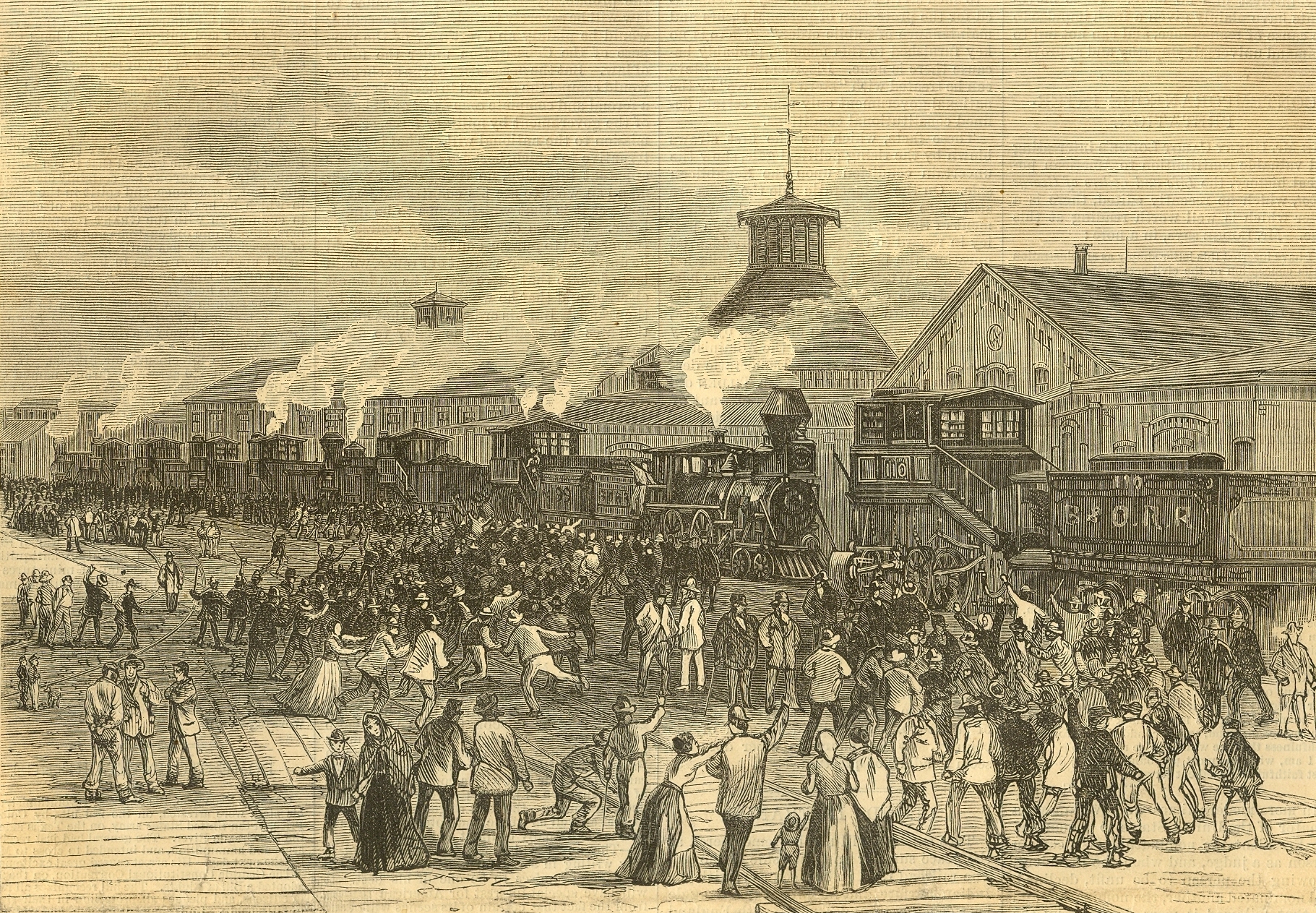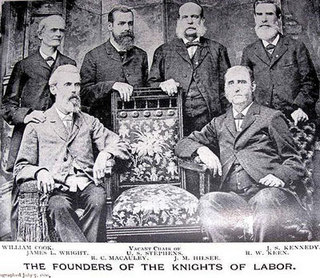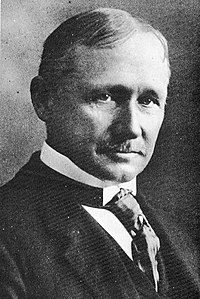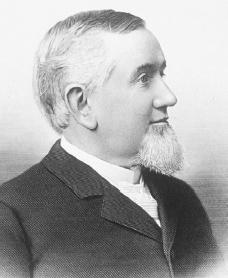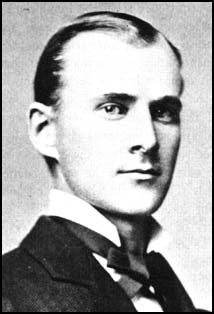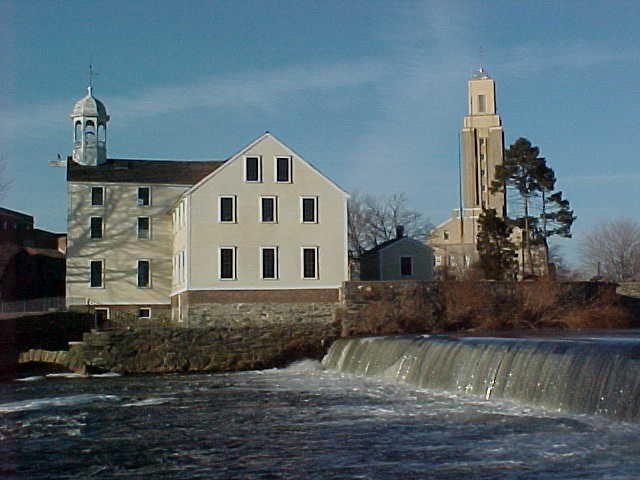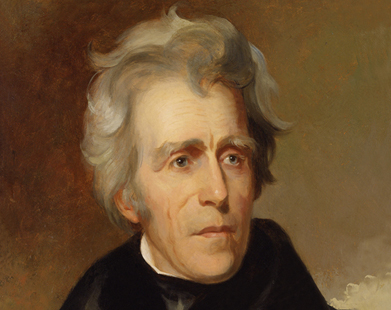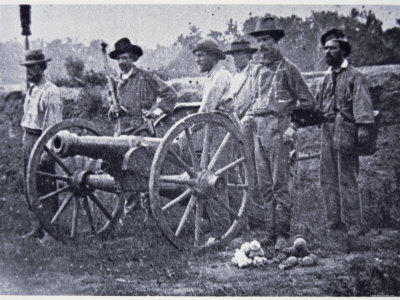Tuesday, January 31, 2012
Written Assignment 4
At the turn of the 20th century, it was said that “Not every laborer is an immigrant, but every immigrant is a laborer.” While this statement was an exaggeration of conditions at the time, it does reflect the fact that the industrial work force in the late 19th and early 20th centuries was composed largely of immigrant workers. What factors led to this development? Why were so many immigrant workers attracted to the United States? What were the effects—political, economic, and social—on the US? Your answer should fill at least to complete pages, machine produced, double-spaced, with conventional one-inch margins and 12-point font. This assignment is due at the beginning of class on Wednesday, February 8.
The Labor Problem in the 19th Century
I. 1877—The Great Upheaval
A. Railroads—the “engine” of economic growth by the mid-19th century, but also caused a great deal of disruption in the neighborhoods that the trains passed through, particularly in this time before the grade the railroad tracks ran on was elevated.
1. Injuries to children—in these neighborhoods, children were regularly injured or killed because they were hit by a train.
2. Injuries to railroad workers—working on a railroad was very dangerous work, and workers were regularly maimed or killed, particularly working in the rail yard, coupling and uncoupling rail cars.
3. Watered stock—in this period of rapid expansion, railroad companies often sold more stock than they had assets or profits to cover; or the board of directors might issue themselves more stock to stave off (or profit from) a merger with another company. This was known as “watering” the stock, and was a huge problem for investors not on the board of directors.
4. Depression of 1873—caused in large part by the bankruptcy of Jay Cooke & Company, a Philadelphia investment bank financing the initial construction of the Northern Pacific Railroad. This depression lasted until 1879.
5. Cost-cutting—then, like today, companies were more concerned with the bottom line than with the well-being of their workers, and immediately began cutting wages and jobs—through thousands of people out of work
B. The Great Upheaval—the continuation of the depression meant that businesses continued to cut wages and workers, particularly in the railroad industry.
1. Martinsburg, WVa—a critical junction of the Baltimore and Ohio Railroad. Workers there decided to strike to attempt to force the company to rescind yet another wage cut in the summer of 1877. Workers prevented trains from passing through Martinsburg, despite the effort of the governor of West Virginia to mobilize the state militia. Workers also used their knowledge of and access to communication technology to workers around the rest of the country.
2. Pittsburgh—inspired by news of events in Martinsburg, and facing similar wage cuts, railroad workers in Pittsburgh went on strike against the Pennsylvania Railroad. When the militia was called up, they chose to bring troops from Philadelphia, were the Pennsylvania Railroad was headquartered. The arrival of this force of “outsiders” sparked a violent confrontation that eventually saw dozens killed, hundreds seriously injured, and much of the huge rail yard in Pittsburgh destroyed.
3. Toledo—In Toledo, agitation for an 8 hour workday for a minimum $1.50 a day wage led a number of workers, inspired by the job action of local railroad workers, to march from manufacturer to manufacturer to ask that the owner concede this demand—and to call for the workers to join the strike if the owner declined. That evening, a cache of arms stored since the abortive Fenian Uprising ten years before helped the local militia of business owners put down the rebellion.
4. St. Louis—inspired and aided by railroad workers, the workers of St. Louis actually engaged in a brief general strike, and workers for a time took over the governance of the city.
5. San Francisco—the Workingman’s Party in San Francisco was largely an instrument of anti-Chinese agitation, and the uprising there quickly degenerated into an anti-Chinese pogrom.
6. Chicago—inspired by the fiery rhetoric of Confederate veteran Albert Parsons and a number of German-American followers of direct-action anarchist Johann Most, workers in Chicago closed down railroad lines, and much else in the city, as well. Although there was not a general strike here as there was in St. Louis, workers sympathetic to the radicals in the Workingman’s Party (in Chicago, this meant the anarchist contingent) regularly struggled against employers in the city—as well as the police force that workers saw working for business interests in the city.
II. 1886 and Haymarket
A. Economic climate—by early 1878, the US economy began to recover from the depression, and there was a brief period of economic growth—and labor quiescence—before the next depression hit in 1883-1884.
B. Knights of Labor (K of L)—founded by nine tailors in Philadelphia in 1869, in the organization’s early years of existence it functioned more as a fraternal organization than a labor union; it eventually emerged as the first general labor union in the United States, however, and attempted to organized all workers in the country without regard to gender or race (with one important exception).
1. Emergence—the K of L emerged in the late 1870s under the leadership of Grand Master Workman Terrence O. Powderly, a former railroad worker. The K of L organized workers into “local assemblies,” which could be based both organized by community location, or by craft.
2. Powderly’s claim—Powderly’s claim to abhor strikes was probably genuine, by the K of L was most successful in organizing workers by leading them into successful strikes.
3. 1885 Southwestern Railway strike—the most successful of the Knight’s strikes, which led to unorganized workers seeking out K of L organizers to join the union.
C. Federation of Organized Trade and Labor Unions (FOTLU) – a rival group to the K of L, consisting of skilled trades workers organized by craft. To set itself apart from the K of L, FOTLU began agitating for a standard 8-hour day in all trades and industries by May 1, 1886.
1. Strike at McCormick Reaper—in late April, workers went on strike for higher wages and a standard 8-hour day at the large factory in Chicago.
2. May Day—May 1, International Workers’ Day, FOTLU called for a one day general strike. A parade of several thousand marched up Michigan Avenue; after the festivities downtown, some workers ended up at the McCormick works to show support for the strikers there. When a sizable contingent of strike supporters showed up again the next day, the police were called out to maintain order; in a confrontation, the police fired on the crowd, killing several.
3. August Spies—in reaction, the editor of the leading German language newspaper called for workers to attend a protest rally at Haymarket Square the next evening—and he advised them to come armed.
4. Haymarket Riot—in dismal weather, a small crowd gathered on the evening of May 3, 1886 to listen to a serious of speeches. As the evening was winding down, a contingent of Chicago police arrived on the scene to ensure the crowd left quickly and peacefully—when someone from the fringe of the crowd through a bomb that landed in the midst of the police. The combination of the bomb blast and the ensuing gun battle caused seven police officers to be killed, and a number wounded. Reliable numbers for the crowd have never been compiled.
I) Homestead
A) Iron and Steel Industry – by the late 1880s and early 1890s, the iron and steel industry had overtaken railroads as the premier industry in the United States. Millions of tons of steel and steel products – rails, armor for railroad cars and locomotives, machines, machine tools (machines that made other machines), as well as for structural support for new high-rise buildings in the larger cities (which we know as skyscrapers).
1) Andrew Carnegie – former railroad executive secretary, Carnegie took the advice of his boss, Pennsylvania Railroad president Thomas A. Scott, and took the opportunity that presented itself to invest in the iron industry.
(a) Carnegie was already a wealth investor when he became involved in the iron and steel industry. Carnegie applied many of the techniques in business management that he learned in the railroad industry (particularly cost-accounting and business coordination, which helped keep his costs well below that of his competitors); he also retained control of the stock of his company, which allowed him to reinvest the profits back into the company, and therefore buy the latest equipment, and hire the best and brightest technical people.
(b) Vertical integration – Carnegie owned not only the steel mills that produced steel, but he also bought the mines that produced the iron ore and coal need for production, the coking plants that produced the needed coke (processed coal), and the railroad cars and shipping fleet needed to bring in the raw materials and distribute the finished product.
(c) Philanthropy – Carnegie used the wealth he helped create to greatly strengthen the public library system in the United States; he also endowed universities, built Carnegie Hall in NYC—and he advocated that other men of wealth follow his lead.
2) The drive to economize – the “secret” of Carnegie’s business success was that his management team was as driven to cut the costs of business as he was (in part because their reward system depended upon it—managers received a substantial portion of the savings they created for the company due to increased productivity; this same opportunity was denied workers who also contributed to this effort by working harder and longer).
(a) Productivity – defined as manufacturing, or making, more of an object at the same or less cost as compared with an earlier time period. Productivity is the basis for capitalist profit, which in theory allows them to “share” their decreased cost with the consumer, so “all” benefit.
(i) Business competition – Carnegie’s compatriots drive to decrease costs tended to drive out of the business those manufacturers who could not keep pace; because of the capital investment to get started in the business, however, a buyer (quite often Carnegie) could be found for the property. With more and more manufacturing capacity being held by fewer and fewer companies, the tendency of capitalist enterprises towards monopoly becomes more pronounced.
(ii) Business cycle – also known as the “boom and bust” cycle; businesses run like crazy to produce goods to sell, the market for a particular good becomes saturated, causing a glut, and then follows a time of little production, until demand picks up again.
(iii) Taylorism – Frederick Winslow Taylor was convinced that he could find the “one best way” to accomplish any job. Taylor himself came from an upper middle class background, but he became a machinist. “Soldiering” and what he perceived as inefficiencies of his fellow workers led him to develop time and motion studies, and to outline management practices devoted to prodding workers to put in 60-minute hours at work.
(b) Technology – this drive for greater levels of productivity also led American industrialists to use more machines than capitalists in other countries
(i) Lack of skilled workers? – Some historians and economists have argued in the past that because the United States allegedly lacked skilled workers, that industrialists relied more on the development of machines and machine tools to compensate. Today this reliance seems to have come about for other reasons
(ii) Labor costs – the increased level of machine use helped capitalists keep down the cost of labor, because the capitalist was able to replace skilled workers (who would have cost him more) with unskilled workers to tend the machines (who cost much less, and were easily replaced should they become recalcitrant.
(iii) This also undermined the position of the union worker, obviously, especially the skilled worker, who made up most of the ranks of the unions belonging to the AFL. Union members within the AFL umbrella fight battles to retain the benefits of the knowledge they had gained from working a particular job.
(i) “Featherbedding” – some AFL unions were successful for a time in keeping workers whose jobs had become technologically obsolete.
(c) Profits – by the early 1890s, the Carnegie Steel Company was making profits of more than $40,000,000 a year
3) Amalgamated Association of Iron, Steel, and Tin Workers (AA) – in 1892, the AA was the largest and strongest union within the AFL, with approximately 24,000 members. The members of the union included only the skilled workers in iron, steel, and tin foundries; not considered for membership was a much larger contingent of unskilled workers, many of whom were new immigrants from Eastern Europe.
B) Homestead and the strike
1) City of Homestead – named after the nearby iron mill, Homestead was located several miles from Pittsburgh, up the Monongahela River. The town was completely dominated by the Carnegie mill—but the town leaders and townspeople identified with the workers more than Carnegie or his managers.
2) Homestead works – Ford C. Frick was hired by Carnegie to rid Homestead of the AA. After putting Frick in charge, Carnegie left for an extended stay in his castle in Scotland, but communicated in secret with Frick.
(a) “Negotiations” – Frick made demands upon the AA which he knew would be unacceptable, and then locked out union members when negotiations broke down in late June. Before the lockout, Frick had an eight-foot steel fence erected around the entire works
(b) Pinkertons – on July 6, a bargeful of 300 Pinkerton agents was discovered motoring up the Monongahela by union lookouts, who quickly notified union members in Homestead. Union members quickly occupied the Homestead works, and a fierce gun battle raged along the riverfront for most of the day, when finally the Pinkerton agents were forced to surrender; agents were forced to run a gauntlet in town, and many were severely injured as a result
(c) Won the battle, lost the war – the Allegheny sheriff was unable to recruit locals to “establish order,” and appealed to the governor for mobilization of the militia, and eight thousand troops arrived shortly to protect strikebreakers
(i) The Carnegie Company had the strike and union leaders arrested, some of who were charged with murder; after trials, all were found not guilty, but the defense efforts depleted the union treasury
III. 1894 Pullman Strike.
A. George Pullman – made his fortune hauling Chicago out of the muck; after the Great Fire of 1871, efforts were made to raise the remaining buildings as much of the swamp that the city was built on was filled. Pullman used this money to establish a company to build sleeping cars used on long trips by railroad companies.
B. Town of Pullman – as the company grew, Pullman became concerned about the effect the radicals in Chicago were having upon his workers, so several miles south of the city he built a town (housing, stores, public buildings, a hotel he named after his daughter Florence, even churches) which he rented to workers, but which he retained title.
1) “Model” town – Pullman the town was a great example of welfare capitalism—that is, subsidizing certain amenities for workers so they remain satisfied on the job.
2) Depression of 1893 – the economic depression of 1893 cut deeply into the profits of the Pullman Company, and Pullman responded by cutting wages and laying off workers, as any good capitalist would do.
(b) Pullman workers respond by going on strike in the spring of 1894.
C. Eugene V. Debs – a former officer of the Brotherhood of Railway Firemen, Debs in early 1894 became president of an early industrial union for railway workers, the American Railway Union.
1) Railway “Brotherhoods” – each specialty in the railroad industry had its own union, The Brotherhood of Railway Engineers, Brakemen, Conductors, Firemen; problems arose when railway companies settled with one of the brotherhoods, and they crossed the picket line while others were still on strike. The ARU is meant to be a solution to this problem.
2) 1894 ARU convention – was held in Chicago; a delegation of workers from Pullman, who plead for the assistance of the ARU. Despite Debs opposition, convention delegates vote to assist Pullman workers, and vote to boycott all trains with Pullman cars. Despite the fact that the ARU represents a relatively small number of workers, traffic all over the country is interrupted.
3) Government response – because there was little violence accompanying the strike the federal government was hamstrung; with a sympathetic John Peter Altgeld as Illinois governor, there was little chance that federal aid would be requested.
(a) Richard Olney – the AG for the federal government was a railroad attorney, and it was he who suggested attaching Pullman cars to mail trains (interfering with the mail is, of course, a federal offense).
(b) Troops from Fort Sheridan (and the Dakotas) are called in “to keep the peace,” which allowed the strike to be broken.
(c) Debs and other union leaders were arrested and held incommunicado, which also helped break the strike; Debs spent a year in jail in Woodstock, Illinois, which he spent reading socialist tracts; he becomes the Socialist Party candidate for president in 1900, 1904, 1908, and 1912, when he polled the largest number of votes to that time in history for a third party candidate.
Sunday, January 29, 2012
Working People Respond to Capitalism
I) Pre-capitalist society – capitalism, in primitive form, had long been a part of American society; what became disturbing to many working people after the Civil War was the fact that more and more power was gathered in fewer hands, and that government seemed to be run for the benefit of the few who had gathered this power.
A) Jeffersonian era
1) Yeoman farmer – the ideal of Jeffersonian/Jacksonian republicanism. The yeoman farmer produced crops for his family’s subsistence; any surplus was used to buy those items that the farmer no longer produced himself, which his family “needed”
(a) Justification for Louisiana Purchase – US needed more land to allow for the expansion of opportunities for the yeoman farmer; since the acquisition of the Louisiana land (encompassing the entire Mississippi River Valley) was contrary to the Jeffersonian philosophy of government (smaller is better). The yeoman (white) farmer did have increased opportunities.
2) Artisans under Jefferson
(a) Artisan system – in the ideal artisan system, when an apprentice spent the term of his apprenticeship (usually seven years, beginning at age eleven or so), he had the tools and ability to begin his work life as a journeyman. After saving his earnings, a journeyman could look forward to settling down and opening his own shop, and taking on apprentices and hiring journeymen. By the dint of hard work and frugality, the master craftsman (as he would be known) could look forward to gaining his competency (enough money to live comfortably without working).
(b) The factory system – the growth of the factory system, which began before Jefferson took office, threatened the artisan system, because it allowed machines to undertake the work formerly done by artisans, which decreased the demand for these artisans, and therefore the wage the artisan could demand—as well as the demand for apprentices, who formerly did much of the work for the artisan.
3) The Bank Question – Jefferson killed the First Bank of the United States, because followers of his faction believed that it concentrated too much power in the hands of too few people
(a) The problem of currency
(i) Paper money – does not really exist at this time, at least as we would recognize it. The government does not issue treasury notes, and the paper money issued (bank notes, discussed below) are not backed by the full faith and credit of the United States government, but by each individual bank and the amount of specie (precious metal coins, also discussed below) that the bank has on hand should someone come into the bank and hand over the bank note in demand for specie.
(ii) Bank notes – each bank issued its own currency, which was a promise to hand over specie if the note was presented at the bank. However, each bank was not required to honor another banks note, but it would often redeem these notes at a discounted (less than face value) rate. This led to confusion and reluctance to accept bank notes as payment, since there was no guarantee that one could redeem a particular note for its face value.
(iii) Specie – coins minted in precious metals (gold or silver), which had value because of the metal contained in the coin. This was the preferred method of payment by debtors (people owed money), but was rarely the method of payment because there was never enough specie available to meet demand.
B) Jacksonian period
1) Yeoman farmer – the “western” (meaning anyone living west of the Allegheny Mountains) farmer was the backbone of the Jacksonian Democratic Party
(a) Indian removal – in order to move white farmers onto land acquired during Louisiana Purchase, those people already living there (the Native Americans) had to be moved off
(b) Land speculation – much of the land was bought up by land speculators, who hoped to sell the land at a profit to potential farmers—which tended to drive up the price of land.
2) Artisans – artisans tended to be Jackson backers as well, because of the animosity of Jackson and his followers to the Second National Bank, and therefore to businessmen. Artisans tended, however, to also be in favor of tariffs (taxes paid on imported goods), which tended to protect their jobs, and Jacksonians tended to be in opposition to this.
3) Bank question – Jackson led the fight to kill the Second National Bank, and Congress refused to renew its charter, so the bank died in 1836. Again, there was opposition to so much control being rested in the hands of so few people, particularly when those people were not responsive to any electorate (the Second National Bank, like the first, was a private company who merely had a privileged relationship with the government—so it was not responsive to the government, or to anyone but the partners or stockholders).
C) Lincoln and the Republican Party—“Free Soil, Free Labor, Free Men”
1) Farmers
(a) Homestead Act – “Free Soil” given to those who promised to improve their claim, which re-opened opportunities for white farmers.
(i) Much of this land was on the Great Plains, which received scant rainfall, and left farmers susceptible to greater chances of failure
(ii) Land could be purchased for cash, as well, which meant that speculators purchased much of the land.
(iii) Land was not likely to favor subsistence farming, and to get grain that was grown to a market, the farmer had to rely upon the nearest railroad.
2) Artisans – artisans and their way of life became more threatened as capitalism advanced, and more trades became mechanized—and new industries (like railroading) developed which trained its own workers, and therefore didn’t use the apprenticeship system.
(a) Artisans may have initially supported the Republican system (and many continued to support it even after the war), but more and more artisans tended to see the interests of the Republican Party as being contrary to their own interests.
3) Laborers – laborers, who generally lacked “skills” defined as labor (as a carpenter, a mason, a shoemaker may be defined as having a skill), generally perceived the Republican Party as contrary to their interests.
(a) Free Labor, Free Men – in the antebellum era, laborers felt threatened by the promise to end slavery; freed slaves, it was thought, would move north and compete for the jobs that white laborers held.
II) Capitalist society – there is no one moment in history that we can pinpoint and say that this was when the US economy became totally oriented toward capitalism; however, in the period after the Civil War, it can safely be said that most of the population of the United States was effected by capitalism.
A) Gold bugs and the Rag Baby – during the Civil War, the US government financed much of the cost by printing money—backed by the full faith and credit of the US government—the first time that the government itself printed promissory notes.
1) Gold bugs – nickname for those people (generally well-to-do businessmen and their mouthpieces) who advocated returning the economy of the country to the gold standard, removing paper money from circulation, and returning the economy to “hard” currency (specie).
(a) Gold bugs tended to be debtors (people who lent money), and wanted to be paid back in a currency that was deflationary—which meant that they would get back the full worth of the money they had lent.
2) Greenbackism – Advocated for greenbacks (also known as “the Rag Baby”) wanted to see the inflationary currency prevalent during the war continue. Greenbackers tended to be creditors (people who had received loans), and therefore wanted to be able to pay back those loans with inflated currency (which would be worth less money).
B) Capitalist control of government – while working people felt that they still had some voice in local government; the further government was removed from local control, the less voice they had in it.
1) Class interests – it becomes apparent, as government at the state and federal level increasingly does the bidding of the capitalist class, that the interests of the working-class is in opposition to those interests.
(a) Definition of class – a group of people who, because of common economic interests, develop a common ideology and outlook.
(b) Collective behavior – when there is a common ideology and outlook, then groups of people can act in a collective manner.
(i) Craft unions – groups of workers joined together by a common identity because of a job skill they have acquired.
(ii) Cartels – groups of capitalists joined together because of the desire to maximize profits while minimizing risks
(iii) Labor unions – groups of workers willing to join together with other workers because of a common economic interest, not necessarily because they share a common job skill.
2) Great Upheaval of 1877 – groups of workers and their families identified with the grievances of railroad workers, and hoped to regain influence with the state and federal government that they felt was usurped by the wealth of capitalists.
(a) Toledo example – workers attempted to close down all businesses that they felt were not paying a “fair” wage ($2.50 and day for skilled workers, $2.00 a day for unskilled); the strike was supported by local elites when its focus was the railroad, but that support quickly diminished when the focus became their own businesses
(i) Toledo, like most other large cities, saw the construction of large armories near their downtowns in the aftermath of the 1877 disturbance. Besides the armory, the local militia was “professionalized” because the number of working people in its ranks was felt to diminish the likelihood that it could be used in a similar occurrence.
Tuesday, January 24, 2012
Written Assignment 3
Much of the reading, and the lecture from this week, focused on the reaction of politicians to the changes in American society that the growing dominance of capitalism caused. Identify those changes, and discuss how the politican systems changed to adapt to those changes. Again, this should be accomplished in a 2-3 page paper, with conventional 1 inch margins and a 12-point font.
Emergence of Class Politics
I. The Farm Crisis – long term decline in commodity prices coupled with tight credit situation meant increasingly difficult times for farmers, particularly in the South and in the Great Plains areas—areas which saw the greatest successes of the Grange, the Farmers’ Alliance, and the People’s party.
A) Economic conditions
1) Decline in commodity prices – from 1870 to 1898, commodity prices on foodstuffs declined, which meant the farmers received less return on the investment they made
2) Dependency on railroads and banks – the economic power of all large corporations frightened many Americans, but particularly the power of railroads and banks. Farmers were entirely reliant upon railroads to get their product to the market, and to receive those items from the market that they wished to buy. Banks controlled credit, and their refusal to make loans to farmers by taking land as collateral meant that many farmers had great difficulty obtaining new machinery and making other capital investments that they felt they needed.
3) Tariff policy – the high tariffs protected US manufacturers from foreign competition, but it also made for higher prices for most consumer goods, which meant that farmers and workers had to spend more of their income for the necessities of life.
B) The Farmers’ Responses
1) Granger Movement – began in 1867 when Oliver H. Kelley wanted to develop a means for Southern farmers to overcome their isolation. Because isolation was a common condition for many farmers, this movement became very popular. Quickly developed into a way for farmers to develop cooperative ventures for the buying and selling of goods, to free farmers from the conventional marketplace. The Granger movement gradually declined (although it never completely vanished) as more and more members were drawn into political movements. The Grange also tended to draw as members the more prosperous farmer.
2) Greenback-Labor Party – advocated the continued use of paper money—known as “greenback”—instead of a return to the gold or silver standard. This inflationary money policy was felt by many farmers to be the root cause of much of their hardships. Greenbackers made alliances with workers organizations because both parties were concerned about the growing influence of monied corporate interests were gaining in the hall of government.
3) Farmers’ Alliance – most popular in the South and the Great Plains are; attracted many poorer farmers than were attracted to the Grange. Although there were not bi-racial local organizations, nor were the national organizations bi-racial, there was limited bi-racial cooperation between white and African American groups in the South—because the Colored Farmers Alliance agreed to limit itself to demands for economic equality, not social equality.
(a) Provided members with sense of community, which attracted a great number of farmers who felt isolated.
(b) Provided farmwomen with a greater sense of purpose, that their lives could encompass more than “Drudgery, fashion, and gossip were no longer the bounds of woman’s sphere.”
(c) Grass roots movement – Alliance cells fostered the development of local leaders; a number of charismatic speakers like Mary Elizabeth Lease (quoted as saying the farmers “should raise less corn and more hell”) and “Sockless” Jerry Simpson.
(d) Use of vigilante justice – farmers often worked in concert against thieves and greedy ranchers, who tried to enclose common grazing areas.
(e) Promotion of racial understanding – in the South, although separate Alliances were maintained for blacks and whites, recognition was beginning to dawn on a number of members that white and black farmers had many things in common; in the words of Southern Alliance leader Tom Watson, “You are kept apart that you may be fleeced of your earnings.”
C) Farmers’ Alliance Proposals
1) Alliance Exchange – proposal by Charles W. Macune to allow Alliance members to sign joint bank notes for loans, and to set up a corporation owned by the Alliance were farmers could buy needed supplies. Plan had to be abandoned when Texas bankers refused to allow farmers to sign joint notes.
2) Subtreasury Plan – proposal by Alliance president Charles W. Macune to allow farmers to store their grain in government owned silos until a higher price was asked for the grain, when the farmer could then sell it at this more favorable higher price; would also allow farmers to obtain low-interest loans up to the value of 80% of his crop. Banks refused to go along with this idea; it was introduced as a bill in Congress, but it was allowed to die in committee
3) Proposals to ease credit restrictions – attempts to pressure bankers to ease credit restrictions
D) The Shift to Politics
1) The People’s Party – many Alliance members developed the idea that they would only see the proposals that they put forth become reality if they were able to exert some political pressure. The People’s Party, or Populists, were more successful in the West (particularly Kansas, Nebraska, and the Dakotas) than in the South, where white voters were extremely resistant to abandoning the Democratic Party
(a) Election of 1892 -- People’s Party run candidates for President (James B. Weaver) and vice-president on a platform backing the subtreasury plan, free and unlimited coinage of silver, a pledge to increase the amount of money in circulation, and institute a graduated income tax. Although Weaver stirs few with the power of his oratory, his candidacy does draw over a million votes—and, more importantly, he carried the states of Colorado, Kansas, Nevada, and Idaho, for a total of twenty-two electoral college votes, enough to give Cleveland the victory over Harrison.
II) The System of 1896 – the response on the part of the two major political parties charted the course for American politics until the onset of the Great Depression and the election of 1932.
A) Depression of 1893 – the most severe economic depression that the United States had faced to that point, set off by the bankruptcy of the Philadelphia and Reading Railroad, which then set off a panic on Wall Street when British investors began pulling financial backing out of American firms and demanding gold payment. Over 750,000 workers eventually went out on strike that year, and millions found themselves suddenly unemployed. Caused in part by a lack of currency in circulation, by the fact that currency growth had not kept pace with the growth of the economy.
1) Silverites and Goldbugs – when the majority of currency in circulation was made of precious metals, the worth of the metal in the coin would supercede its worth as currency, and therefore people would not spend it (especially true for gold).
(a) “Free and unlimited coinage” – people would present their gold or silver to the government, which would make coins of it; once gold or silver was turned into a coin, it was no longer able to fluctuate with the value of the precious metal that it contained.
2) 1894 Election – not surprisingly, many people blamed the party that controlled the White House for this fiasco, and returned majorities for the Republican Party in both the House and the Senate.
B) William Jennings Bryan – the “Boy Orator of the Plains.” Bryan seized upon the silver issue, and made it his own. Bryan was also the first politician from a major party to identify with the (white) underclass, mainly the small farmer, because his devotion to the tenets of his Baptist creed largely prevented immigrant workers in cities from identifying with him or his cause (a fact that proved fatal in the fall election that year).
1) “Cross of Gold” speech – speech before the Democratic convention in 1896 brought many in the audience to tears with its eloquence; however, it did not persuade all of the members of the party to back his candidacy after Bryan won the nomination—the goldbug faction of the party walked out of the convention and named their own candidate, Alton Parker, who promptly proclaimed that he saw no reason for a gold Democrat not to vote for the Republican candidate, William McKinley.
2) Split of Democratic Party – essentially remains unhealed until the rise of FDR in 1932, when he is able to patch together a coalition of urban ethnic workers, blacks, and Southern plutocrats.
C) Marcus J. Hanna – Cleveland oil man, associate of John D. Rockefeller, in politics to further his economic ends and those of his friends. Although he was only the campaign manager for McKinley in this election, he is by far the more important figure.
1) The Businessman’s Tax – because of the enmity that Bryan stirred in the business class, with his appeals to small farmers, workers, and the downtrodden, Hanna was able to essentially “tax” a number of businessmen in the country, to the tune of somewhere between $3.5 and $7 million (compared to Bryan’s war chest of $300,000), which allowed the McKinley campaign to outspend Bryan by a 15 to 1 margin.
2) “Economic Chaos” – businessmen promise they will close down their factories if Bryan were elected; this dissuades many workers who may have been inclined to overlook Bryan’s fundamentalist side to vote for McKinley instead.
D) The Forces of “Good Government” – as a result of the forces unleashed in the period after the Civil War, which seemed to be coming to a head at the end of the 1890s, dramatic changes in the way local governments are constituted quickly evolve.
1) Attempts to remove politics from local government.
(a) Development of City Manager style government – the cities of the South first develop this; suppose to put the reigns of power in a city in the hands of an “expert” and remove the hazards of politics from government. In effect, this removes the governing of the city from its citizens, who have no direct say in who is responsible for the day-to-day running of the city.
(b) At-Large Elections – again removes responsibility from those elected, which is no longer answerable to any one constituency—except that constituency which can afford to provide campaign funds.
III) Conclusion – the growth of the Progressive Movement is spurred by the “dangers” that the conflict between capitalists and labor seems to hold for the ability of the upper middle class to retain control of the body politic; most of the people who become associated with the Progressive Movement are in fact working to regain that control.
A) Economic conditions
1) Decline in commodity prices – from 1870 to 1898, commodity prices on foodstuffs declined, which meant the farmers received less return on the investment they made
2) Dependency on railroads and banks – the economic power of all large corporations frightened many Americans, but particularly the power of railroads and banks. Farmers were entirely reliant upon railroads to get their product to the market, and to receive those items from the market that they wished to buy. Banks controlled credit, and their refusal to make loans to farmers by taking land as collateral meant that many farmers had great difficulty obtaining new machinery and making other capital investments that they felt they needed.
3) Tariff policy – the high tariffs protected US manufacturers from foreign competition, but it also made for higher prices for most consumer goods, which meant that farmers and workers had to spend more of their income for the necessities of life.
B) The Farmers’ Responses
1) Granger Movement – began in 1867 when Oliver H. Kelley wanted to develop a means for Southern farmers to overcome their isolation. Because isolation was a common condition for many farmers, this movement became very popular. Quickly developed into a way for farmers to develop cooperative ventures for the buying and selling of goods, to free farmers from the conventional marketplace. The Granger movement gradually declined (although it never completely vanished) as more and more members were drawn into political movements. The Grange also tended to draw as members the more prosperous farmer.
2) Greenback-Labor Party – advocated the continued use of paper money—known as “greenback”—instead of a return to the gold or silver standard. This inflationary money policy was felt by many farmers to be the root cause of much of their hardships. Greenbackers made alliances with workers organizations because both parties were concerned about the growing influence of monied corporate interests were gaining in the hall of government.
3) Farmers’ Alliance – most popular in the South and the Great Plains are; attracted many poorer farmers than were attracted to the Grange. Although there were not bi-racial local organizations, nor were the national organizations bi-racial, there was limited bi-racial cooperation between white and African American groups in the South—because the Colored Farmers Alliance agreed to limit itself to demands for economic equality, not social equality.
(a) Provided members with sense of community, which attracted a great number of farmers who felt isolated.
(b) Provided farmwomen with a greater sense of purpose, that their lives could encompass more than “Drudgery, fashion, and gossip were no longer the bounds of woman’s sphere.”
(c) Grass roots movement – Alliance cells fostered the development of local leaders; a number of charismatic speakers like Mary Elizabeth Lease (quoted as saying the farmers “should raise less corn and more hell”) and “Sockless” Jerry Simpson.
(d) Use of vigilante justice – farmers often worked in concert against thieves and greedy ranchers, who tried to enclose common grazing areas.
(e) Promotion of racial understanding – in the South, although separate Alliances were maintained for blacks and whites, recognition was beginning to dawn on a number of members that white and black farmers had many things in common; in the words of Southern Alliance leader Tom Watson, “You are kept apart that you may be fleeced of your earnings.”
C) Farmers’ Alliance Proposals
1) Alliance Exchange – proposal by Charles W. Macune to allow Alliance members to sign joint bank notes for loans, and to set up a corporation owned by the Alliance were farmers could buy needed supplies. Plan had to be abandoned when Texas bankers refused to allow farmers to sign joint notes.
2) Subtreasury Plan – proposal by Alliance president Charles W. Macune to allow farmers to store their grain in government owned silos until a higher price was asked for the grain, when the farmer could then sell it at this more favorable higher price; would also allow farmers to obtain low-interest loans up to the value of 80% of his crop. Banks refused to go along with this idea; it was introduced as a bill in Congress, but it was allowed to die in committee
3) Proposals to ease credit restrictions – attempts to pressure bankers to ease credit restrictions
D) The Shift to Politics
1) The People’s Party – many Alliance members developed the idea that they would only see the proposals that they put forth become reality if they were able to exert some political pressure. The People’s Party, or Populists, were more successful in the West (particularly Kansas, Nebraska, and the Dakotas) than in the South, where white voters were extremely resistant to abandoning the Democratic Party
(a) Election of 1892 -- People’s Party run candidates for President (James B. Weaver) and vice-president on a platform backing the subtreasury plan, free and unlimited coinage of silver, a pledge to increase the amount of money in circulation, and institute a graduated income tax. Although Weaver stirs few with the power of his oratory, his candidacy does draw over a million votes—and, more importantly, he carried the states of Colorado, Kansas, Nevada, and Idaho, for a total of twenty-two electoral college votes, enough to give Cleveland the victory over Harrison.
II) The System of 1896 – the response on the part of the two major political parties charted the course for American politics until the onset of the Great Depression and the election of 1932.
A) Depression of 1893 – the most severe economic depression that the United States had faced to that point, set off by the bankruptcy of the Philadelphia and Reading Railroad, which then set off a panic on Wall Street when British investors began pulling financial backing out of American firms and demanding gold payment. Over 750,000 workers eventually went out on strike that year, and millions found themselves suddenly unemployed. Caused in part by a lack of currency in circulation, by the fact that currency growth had not kept pace with the growth of the economy.
1) Silverites and Goldbugs – when the majority of currency in circulation was made of precious metals, the worth of the metal in the coin would supercede its worth as currency, and therefore people would not spend it (especially true for gold).
(a) “Free and unlimited coinage” – people would present their gold or silver to the government, which would make coins of it; once gold or silver was turned into a coin, it was no longer able to fluctuate with the value of the precious metal that it contained.
2) 1894 Election – not surprisingly, many people blamed the party that controlled the White House for this fiasco, and returned majorities for the Republican Party in both the House and the Senate.
B) William Jennings Bryan – the “Boy Orator of the Plains.” Bryan seized upon the silver issue, and made it his own. Bryan was also the first politician from a major party to identify with the (white) underclass, mainly the small farmer, because his devotion to the tenets of his Baptist creed largely prevented immigrant workers in cities from identifying with him or his cause (a fact that proved fatal in the fall election that year).
1) “Cross of Gold” speech – speech before the Democratic convention in 1896 brought many in the audience to tears with its eloquence; however, it did not persuade all of the members of the party to back his candidacy after Bryan won the nomination—the goldbug faction of the party walked out of the convention and named their own candidate, Alton Parker, who promptly proclaimed that he saw no reason for a gold Democrat not to vote for the Republican candidate, William McKinley.
2) Split of Democratic Party – essentially remains unhealed until the rise of FDR in 1932, when he is able to patch together a coalition of urban ethnic workers, blacks, and Southern plutocrats.
C) Marcus J. Hanna – Cleveland oil man, associate of John D. Rockefeller, in politics to further his economic ends and those of his friends. Although he was only the campaign manager for McKinley in this election, he is by far the more important figure.
1) The Businessman’s Tax – because of the enmity that Bryan stirred in the business class, with his appeals to small farmers, workers, and the downtrodden, Hanna was able to essentially “tax” a number of businessmen in the country, to the tune of somewhere between $3.5 and $7 million (compared to Bryan’s war chest of $300,000), which allowed the McKinley campaign to outspend Bryan by a 15 to 1 margin.
2) “Economic Chaos” – businessmen promise they will close down their factories if Bryan were elected; this dissuades many workers who may have been inclined to overlook Bryan’s fundamentalist side to vote for McKinley instead.
D) The Forces of “Good Government” – as a result of the forces unleashed in the period after the Civil War, which seemed to be coming to a head at the end of the 1890s, dramatic changes in the way local governments are constituted quickly evolve.
1) Attempts to remove politics from local government.
(a) Development of City Manager style government – the cities of the South first develop this; suppose to put the reigns of power in a city in the hands of an “expert” and remove the hazards of politics from government. In effect, this removes the governing of the city from its citizens, who have no direct say in who is responsible for the day-to-day running of the city.
(b) At-Large Elections – again removes responsibility from those elected, which is no longer answerable to any one constituency—except that constituency which can afford to provide campaign funds.
III) Conclusion – the growth of the Progressive Movement is spurred by the “dangers” that the conflict between capitalists and labor seems to hold for the ability of the upper middle class to retain control of the body politic; most of the people who become associated with the Progressive Movement are in fact working to regain that control.
Subscribe to:
Posts (Atom)


